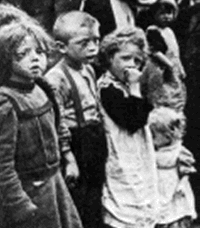The Race Issue and Economic growth in the South after the Civil War
Historic-economists researching economic growth usually tend to view the societies they study as being laboratories with the economic factors of labor and of capacity and capability of the land. Social-historians tend to inspect the build of the society in which economic growth is taking place, without linking the kind of growth or development to the importance and the kind of society. This scholarly problem is to be found in all the major topics of history. One of the most important cases in which the society played a decisive role in the economic and industrial growth is the case of the Southern States of America. I would like to argue that the economic underdevelopment of the Southern States (from here on to be referred to as “the south”) is not to be seen without the Social, Economical and Political influence of the “Race Issue”.
Let me at first define “Race Issue”: The struggle of the Black Population in the South for social equality, political influence and economic independence after the civil war. I would like to discuss this struggle divided into the three mentioned categories and the influence they all have on both the development of the South internally, the United States as a whole and the international role of the South. I would like to explore the argument that the race issue was the single most important factor for the structural underdevelopment of the south after the civil war and during the industrial growth of the urban North.
Looking at the social structure of the South one immediately notices three elements which form the core of economic development: cash crop mono culture, the plantation system and Negro slavery. In order to achieve progress and agricultural innovation diversification is needed. In early colonial times a modest form of diversification existed, but with the coming of the Cotton gin cotton was boosted to number one product. With the elimination of the small manufactures there could be no economic reason to end slavery or the plantation system.
Economically speaking one of the biggest impacts of the civil war was the forming of a big group of poor white people. These former landholders had now become a planter's overseer, or they might, rarely become a planter themselves. The third element, Negro slavery, was officially abolished after the Civil war and yes, some things changed for the positive; Slaves were now free and were able to take the risk of moving away from their former life to start over in the North.
However, most of the time, and considering the era we are discussing, this was too big a risk. Most former slaves had to find a new way to support their family. This usually resulted in a renewed contract with the former slaveholder, who was now a landholder. This new system is referred to as Share-cropping. The former slave was able to live where he wanted but was still attached to the land in a form comparable with European Feudal connections.

Combining the three elements one can conclude several things that have their reflection in the economy and in politics. First of all the weight given to cotton kept the workers, both black and white, uneducated and untrained in more sophisticated labor. This kept the agriculture monotonous and held back innovation, which caused the hard work to be needed. Then there was the new lower class existing of white laborers. This group demands a more complex approach to the problem, and this is where the race issue enters the case.
It is difficult to try and explain what caused this way of thinking, and to this essay it should not be discussed. The situation is like this: The civil war changed the identity of the landowner in the south, he was now more than before absent, a northerner and had more land, causing white people, as mentioned before, to become landless peasants. This meant a major leak in the middle class white population of the south. This process had two consequences. For the white elite, that was left in power, to keep status quo, a hypocritical construction was needed to keep the economy from free falling and to keep the poor white people from political power. This system is called: racial control through “white supremacy”. By making, or keeping, the white workers uneducated, the white elite made the white bottom believe that, though being very poor, they were not the bottom of society. They had a scapegoat in the black former slaves. Bookmarking this type of social structure one can only conclude and view in the decades following the society being split into two artificial social groups: White people, either very rich or very poor, and Black people, usually indebted to a white landholder. Through this social system the South rapidly fell into a downward spiral of rural idleness. It was not until the civil rights movements of the fifties that this spiral could be broken.

An Industrial Revolution eventually did occur in the south due to major investments from the North and from England, the Empire. Why did these investments take place? The south had (and still has) plenty of raw industrial materials and easy accessible power sources, but the most important reason, which made investments cheap and profitable for investors was a large and cheap unused or underused labor pool. Put in harsh economic language: the 'foreign' investors created an outlet for the impoverished labor force. What made the white people stay at these intensive uninnovative work? According to Douglas F. Dowd there are four factors.
The abundance of labor, the fast they had been lifted from the brink of starvation “an inch of two”, the continuation of the plantation life in the mill towns and the “race issue”. Before further exploring the role of race there is yet the economic comparison between the Industrial revolution in England and the South of the U.S. There lies the obviousness of Southern backwardness. The single agricultural product became a single industrial product and funding came from outside investment and that is where the profits went to as well.
Now, to sharpen the connection between the Southern industrial revolution and the race issue, it is important to realize that prior to the civil war the black population was economically subjected to the white population via the institution of slavery. After the abolition and especially during industrial growth the white and black population were able to compete economically, which kept both impoverished. To avoid disaster within the white community the myth of white supremacy was held high and the segregation grew. For the south to survive in this fashion politics had to be simple and choreographed.
As the south was economically Dependant on the north, it was able to maneuver solo on the political front. It was conservatism and backwardness that kept southern politics white and southern economy weak and Dependant. Another complex circularly structure is the white southern middle class and their ideals. These were the merchants, lawyers and bankers of the south.
They held economic and political power. But holding on to their single-minded Democratic Party they placed the race issue at the top of every political agenda, thus losing any influence the south had in the United States as the north gave up political control and settled for economic exploitation.
It is striking to witness how much influence the social structure and social expectations and needs of the ruling group have in the process of economic growth. These matters are very complex and it is not possible to pinpoint the race issue as the single most decisive factor. But it cannot be denied that in southern economy and politics the race issue runs as a thick red line.
Nothing can be said about the history of the south without considering the role played by the black population, their stance in society and their economic strength. Approaching economic issues in these kind of societies throughout history always shows how economy is just another expression of human and social behavior, and not an abstract based on natural laws.



 It was after the Gulf War that his mother and boyfriend at the time decided to 'descend' from the Holy land and set sail towards The Hague, being the birthplace of Even-Zohars
mother. Jonathan managed well in Grade school and High school, so the
next logical step was the University, the infinite source of knowledge.
After speculating on Industrial Design, Social Geography and Journalism
it was the study of History at Leiden that turned out to be his
decision.
It was after the Gulf War that his mother and boyfriend at the time decided to 'descend' from the Holy land and set sail towards The Hague, being the birthplace of Even-Zohars
mother. Jonathan managed well in Grade school and High school, so the
next logical step was the University, the infinite source of knowledge.
After speculating on Industrial Design, Social Geography and Journalism
it was the study of History at Leiden that turned out to be his
decision.
 Now, four years into the study, matters have only become more
complicated as this student advances towards World History; meaning the
complete array of fields a historian may implement in explaining the
entire past of the entire world to fellow men. It is especially the
philosophical character of World History that attracted Jonathan.
Now, four years into the study, matters have only become more
complicated as this student advances towards World History; meaning the
complete array of fields a historian may implement in explaining the
entire past of the entire world to fellow men. It is especially the
philosophical character of World History that attracted Jonathan.
 For him there is only one question that stands above all others like a
lonely chuchtower in some Flemish village, which asks the cause of the
Western Rise and the Industrial Revolution. Furthermore, the role of the
European self- and worldimage throughout its history may explain the
role of Europe in the Eurasian Human Web. Thus, the direct contact
between Islam and Christianity is to be investigated. Were Muslims
constantly on the verge of invading Europe? How did Arab people perceive
the 'barbaric' Christians? How was Science spread and how did the West
pick up knowledge form the Arabs or from further East? Europe and the
Islam are still not at peace, certainly not in the mind.
For him there is only one question that stands above all others like a
lonely chuchtower in some Flemish village, which asks the cause of the
Western Rise and the Industrial Revolution. Furthermore, the role of the
European self- and worldimage throughout its history may explain the
role of Europe in the Eurasian Human Web. Thus, the direct contact
between Islam and Christianity is to be investigated. Were Muslims
constantly on the verge of invading Europe? How did Arab people perceive
the 'barbaric' Christians? How was Science spread and how did the West
pick up knowledge form the Arabs or from further East? Europe and the
Islam are still not at peace, certainly not in the mind.
0 Comments:
Post a Comment
<< Home